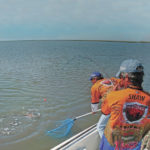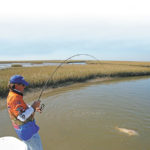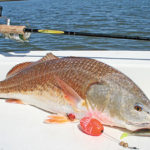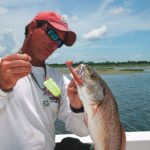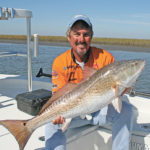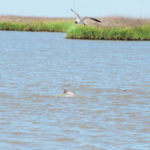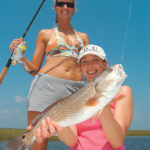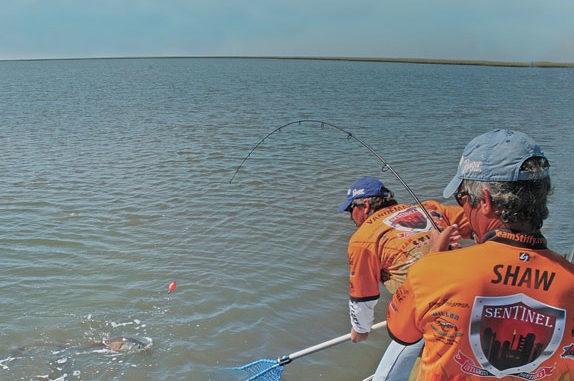
Think corks are too clunky to attract bites from redfish in shallow water? Actually, this team is proving there may not be a better way to fish them.
Tournament redfishing — love it or hate it — has played an unquestioned role in two things: 1) permanently etching Louisiana as the redfish mecca, and 2) establishing competitors as innovators in catching fish regardless of conditions.
Some time ago, competitors discovered the virtues of one of the more ubiquitous weapons of Bayou State fishermen — the popping cork. Or floats. Or strike indicators. Whatever you want to call them, call them successful because their use put a whole lot of dough in a whole lot of pockets when the tournament trails pushed through storm-ravaged Southeast Louisiana.
Pro anglers Kevin Shaw and Tadd Vandemark — natives of Corpus Christi, Texas, and Key Largo, Fla., respectively — pretty well laid waste to the 2008 tournament field. Particularly late in the season when Hurricanes Gustav and Ike churned through the coastline like a fresh trolling motor prop through coontail, the duo adjusted their techniques while sticking largely to proven, though seemingly shattered, areas.
“We do a good bit of sight fishing in most of our tournaments, but we also strongly believe in adjusting to what the water gives us,” said Shaw, president of Stiffy, a manufacturer of high-end push poles and fishing rods. “Using floats (not corks, mind you) doesn’t really fit the profile of redfish tournaments, but it became an invaluable tool for us later in 2008. The high, mostly dirty water pretty much made it a necessity.”
He and Vandemark have been fishing and competing in Southeast Louisiana for many years now, spending countless hours exploring the marsh for redfish around tournament jumping off spots such as Hopedale, Venice, Lafitte and Cocodrie. So while they’re anything but natives, they match up with most anyone in terms of time on the water.
Venice and its maze of deltaic ponds and flats hold a special place in the hearts of most cast-for-cash redfishermen with its loads of plump fish in the upper slot. Shaw and Vandemark are no exceptions, but even they were initially discouraged by the damage done by successive September 2008 body blows brought on by Gustav and Ike. The team realized that though their productive areas were largely stripped of aesthetic value, they were by no means barren.
“The water was high and, for the most part, it was dirty. We couldn’t see the fish like we’re all accustomed to seeing them in Venice that time of year,” said Vandemark. “But there were certain spots that were just covered up with fish.”
Not at all coincidentally, these places were holding vast schools of pogies, the protein-packed superfood that just about everything revolves around in the delta in early fall. The duo found that the most productive way of working these dirty-water fish was by casting a cork rig to them.
But simply slipping a cork onto their lines wasn’t all there was to it. The team had travelled long and burned a lot of gas to find the fish. Maximizing the catching was now on their minds.
“What we found were a few little intricacies that really helped our production. And in some cases, it made all the difference in the world,” said Shaw.
I met up with the team a couple years back, the day after Halloween and on what they had hoped would be the third and final day of the FLW Redfish Series Championship, where the top five teams duke it out. The tournament was being held in Biloxi, though most every team had traveled south to Louisiana waters, some as far as South Pass in Venice. Shaw and Vandemark were no exceptions, knowing that their bread was buttered on the incredible numbers of plump, slot-sized redfish provided by the Bayou State.
We edged out of the marina at the Grand Casino after everyone had shaken off the cobwebs of the Halloween festivities of a few hours before, and pointed the 22-foot Ranger toward the Louisiana Marsh, where the team had missed being included in the top five by less than half a pound.
This area was a far cry from the tropical system-stained water of Venice. Situated north of the Biloxi Marsh, the Louisiana Marsh takes on a pure salt-marsh personality with the ubiquitous Spartina (oyster grass) and plentiful oyster beds that are a long, expensive haul from most any jumping off spot. The cooling water temperatures had rid the area of much of the algae and plankton, and the water sparkled a pretty green.
It wasn’t — on the surface — the best of areas to test the merits of floats for redfish.
“What we use is a Cajun Thunder float,” said Shaw, who went on to explain how the owner of the company had gone to great lengths in explaining that they were not to be called corks, something I consistently failed at doing throughout the day.
We pulled into the pond where the team had taken their sixth place showing the day before, and sure enough, it was typical of the type of water that float fishing was not meant for. Clear water gave away every detail of the oyster-studded bottom.
“It’s always good to have one rigged up. The float, with all of its brass and lead and glass beads, is easy to get good distance with, even against the wind,” said Shaw, who nearly always uses spinning tackle in his fishing.
Casting a float rig with a revolving-spool reel is simply asking for trouble.
As soon as the trolling motor was dropped, Vandemark pointed to a tailing fish in the shallows up ahead. But before we could ease into easy casting distance, the unmistakable crash of a heavy redfish came from the middle of the pond. Pods of pogies were still gathering themselves from the attack when Shaw launched a cast from the back of the boat. The float landed, was given a three count and then lurched forward with a quick flick of the wrist from Shaw.
The fish, obviously not satisfied with its oily menhaden meal, took a liking to the bright orange float, and bowed up on it from the right. Shaw gently pulled it from the pursuing fish, exposing a tastier morsel in the form of a Fishbites shrimp tail.
“That’s the thing you’ve got to do, and it’s something that we learned through trial and error all those weeks down in that dirty water in Venice,” said Shaw, as he swung on the fish a second after the float vanished. “If you let the fish eat the float, he’s gone, and you’ll never get him back. They’ll often nose up on it like that one, but you can’t let him take a bite.”
The fish streaked toward the ditch where we had entered as Shaw continued Floats for Reds 101.
“Another really important thing is to not take it away from the fish too hard. If you pop it, they’ll generally spook, no matter how fired up they are,” said Shaw, further explaining the fine line in fulfilling both requirements of taking it away just gently enough to prevent mouthing of the float and just hard enough so as to not spook the fish.
The Cajun Thunder Float is pretty typical of any number of tie-on floats that have a wire through the middle of it and brass and glass beads on either end. The one thing that sets it apart in Shaw/Vandemark’s eyes is the piece of plastic used to cover the lead at the bottom of the float.
“That little piece of plastic, as much as anything, is what gives the Cajun Thunder its edge,” said Vandemark, who is also a full-time guide when not on the tournament trail. “It gives the float a little snap and a gurgle when you work it. And when it wears off, we immediately switch it out.”
Making as many casts as these guys do in a day makes for a lot of pops — so much so that fresh floats are needed on average every day. A combination of the floats being attacked themselves by ravenous reds and the constant hammering of the critical plastic piece with each fish-calling pop make them susceptible to wear and tear. Shaw says that’s one thing not to go cheap on when fishing.
“It’s important to keep a good number of floats in the boat during a trip. One thing we’ve learned through all of this is that the slightest little thing can really make a big difference in how many bites you get,” said Shaw.
Floats were also very effective in areas where grasslines were holding fish in dirty water and catching them required a little finesse in the working of the float. Often the difference in getting a bite was in how many pops were made while the bait was in the strike zone.
“We had a few situations where the fish were holding in a 3- to 5-foot zone just off of this grass line. The wind was blowing like crazy, and the water was dirty from the hurricanes having just pushed through,” explained Shaw. “There were plenty of fish in there, and they were really eating up, but it was crucial to keep the bait in that zone and to give them time to find it in the dirty water.
“We actually used the wind to our advantage in that case. It would put just enough of a bow in it that each pop would only move it a few inches. Sometimes you would need a bunch of pops before the fish could find it and eat it.”
The team talked about how critical it is to pay attention to the depth of the water, and adjust the floats accordingly.
“Again, this was revealed to us mostly by trial and error, but we’ve taken it and applied it to almost every situation. We were on this school of fish in a really tight area down in Venice, and they were actively feeding, but I was getting 10 or so bites for every one that Tadd was getting,” said Shaw. “It was just ridiculous. Everything was the same except that my leader was about 3 inches longer than his.
“We would cast in the same exact place; I’d get a bite, and he wouldn’t. Finally, I brought in a cast with a strike, and a little piece of grass was lodged in between the jighead and the shrimp tail. We figured out that the extra 3 inches of leader was allowing the jig to lay on the bottom and every pop was producing a little puff of mud. That’s what was driving the fish crazy.”
So, yeah, it doesn’t look so complicated tossing a float rig for redfish. But paying a little bit of attention to detail can pay big dividends at the end of the day.
